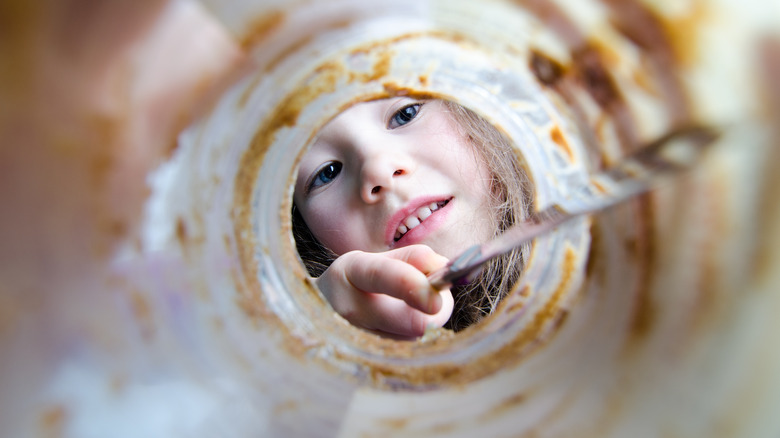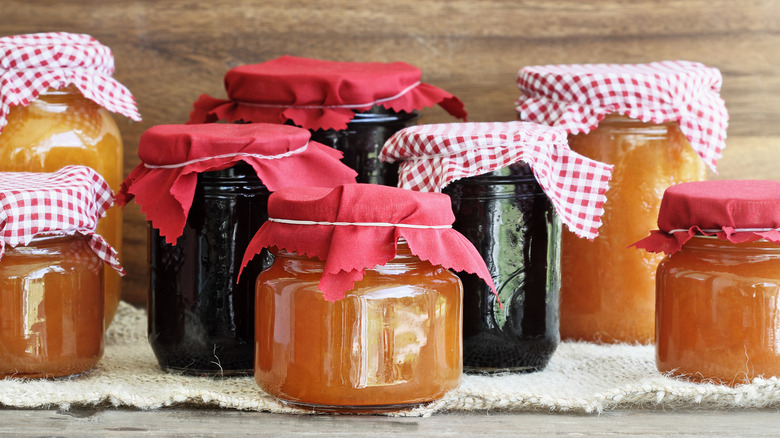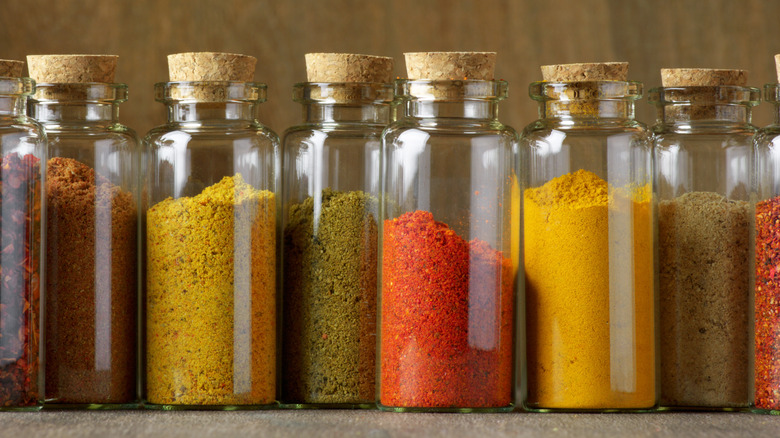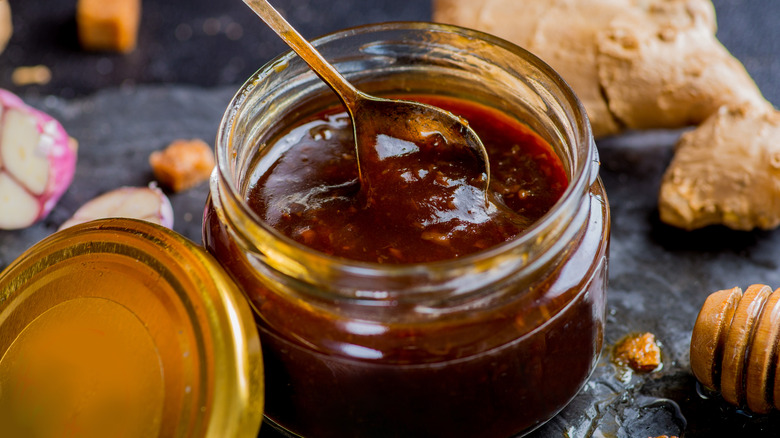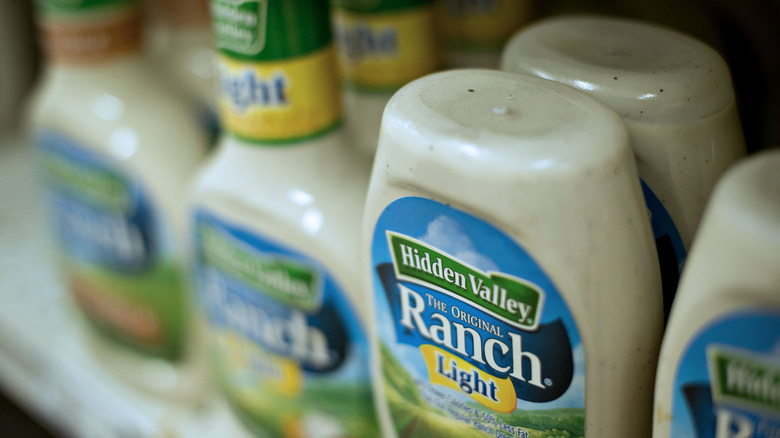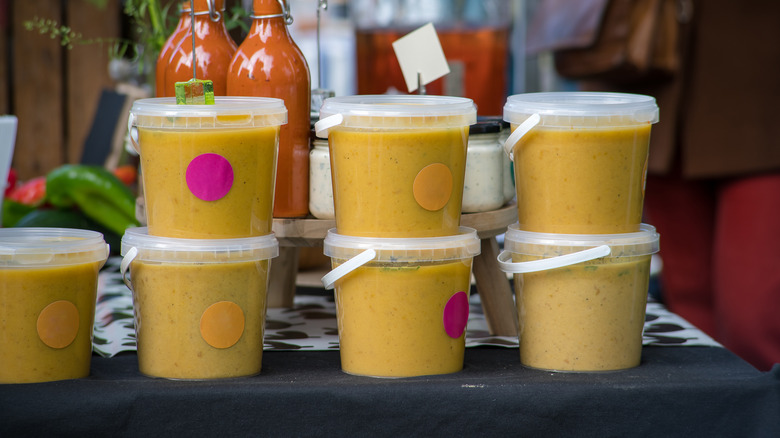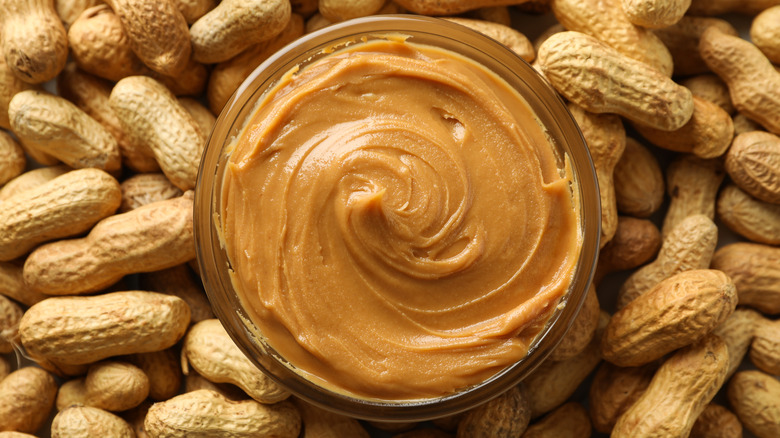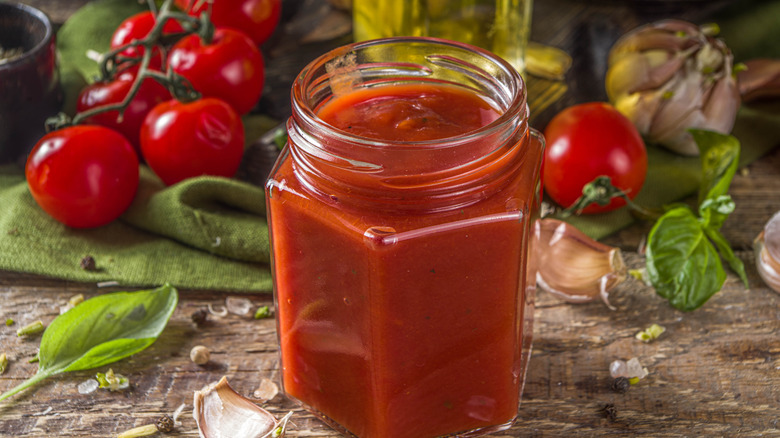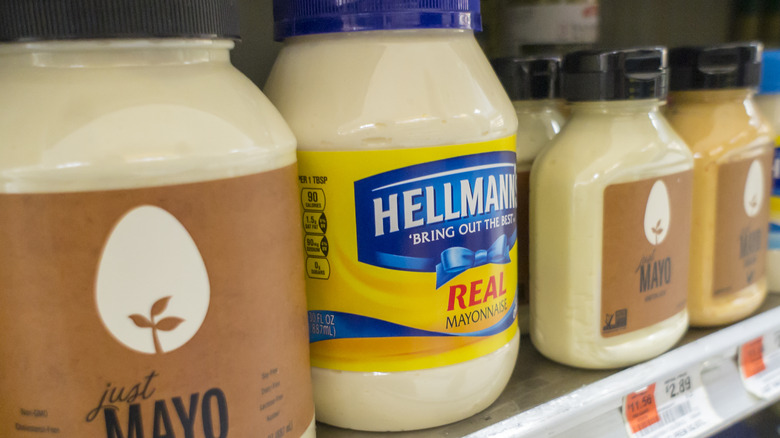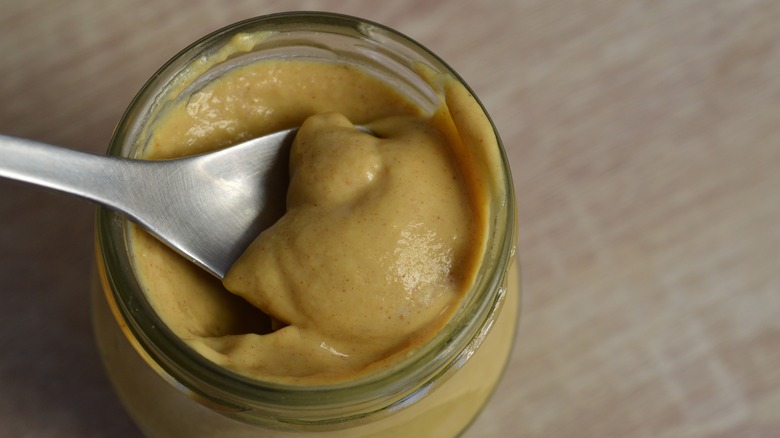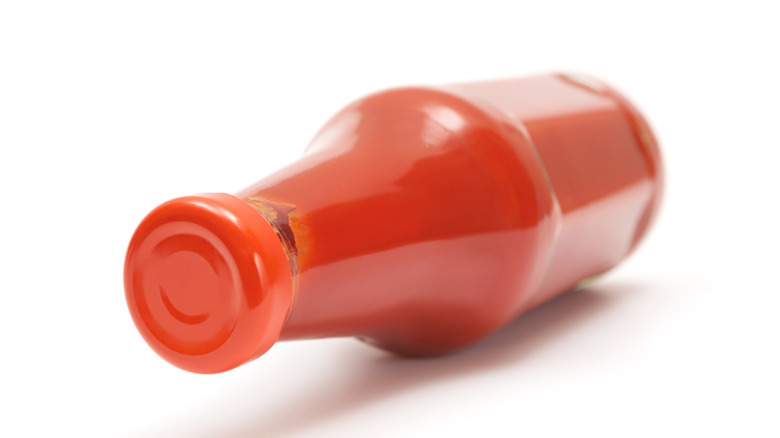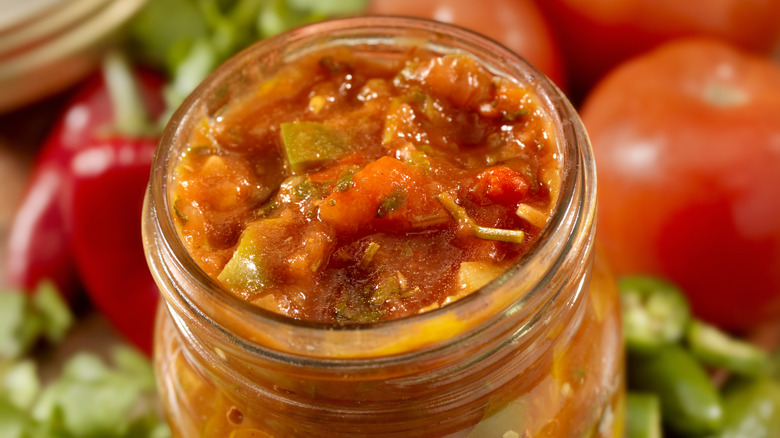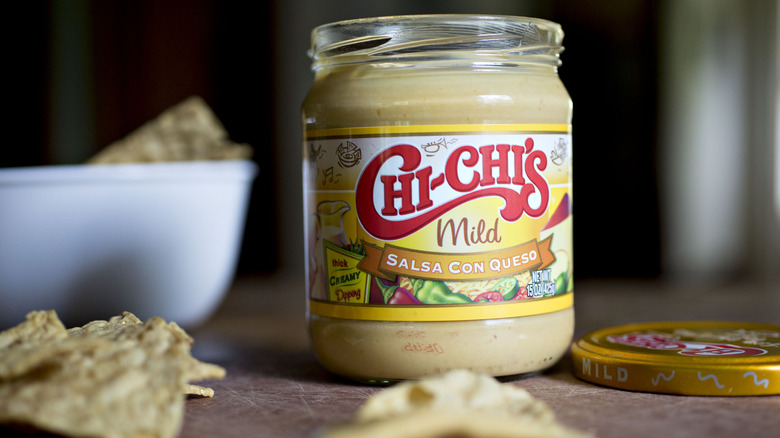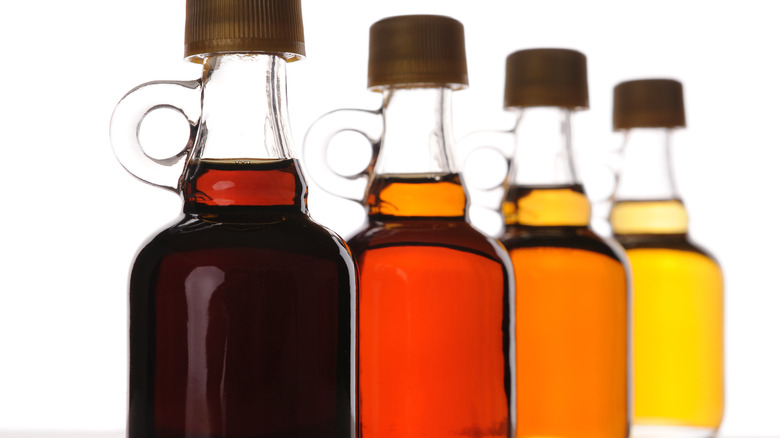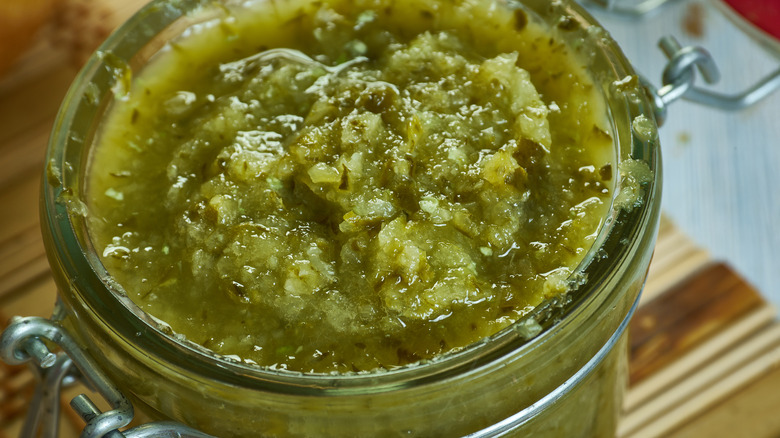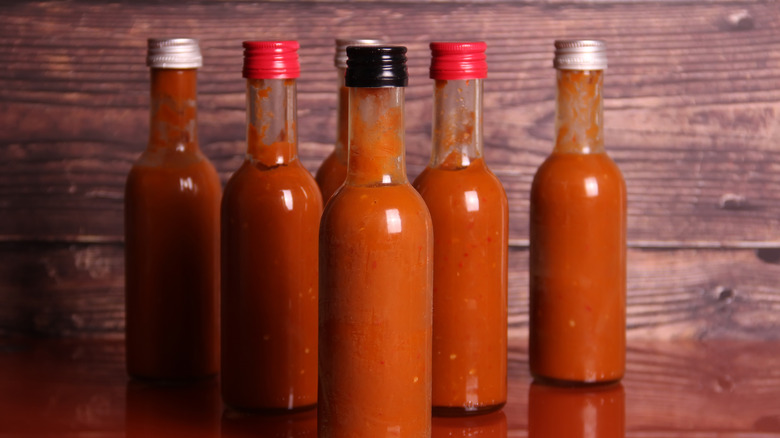16 Hacks To Get More Out Of Near-Empty Jarred Goods
Jarred foods are one of the greatest inventions of the last few hundred years. But we're betting that ever since 1809 when France's Nicolas Appert learned that you could preserve food by heating it to a certain temperature and then sealing it into a jar, they've also been one of humankind's greatest sources of aggravation. Why? Think about the last time you emptied a jar of peanut butter or mayonnaise and then found yourself staring deep inside that container. There's inevitably going to be some delicious looking bits of food stuck in the bottle — and try as you might with spoon or spatula, you never can seem to get it all out of the jar and use it.
Fortunately, we've got a secret. Whether you're dealing with store-bought goods or something you canned and preserved yourself, you no longer need to struggle to get those bits of leftover pasta sauce, cream soup, or ketchup out of the container. With a few simple tricks — some added olive oil, a dash of soy sauce, a microwave — you can salvage almost anything left in that bottle or jar and use it as part of a meal. So before you throw that thing into the recycling bin, make sure you've tried these essential hacks to get more out of any near-empty jarred good in your kitchen.
Add water to your jam jars
It doesn't matter if you're emptying a jar of strawberry jelly, raspberry preserves, or orange marmalade, fruit-filled jam and jelly jars are notorious for being especially hard to empty completely. To get out that last remaining fruity ambrosia, try pouring a small amount of warm water, juice, or even a favorite liquor into the jar. Pop the top back on the jar, shake gently — and then vigorously if needed — and then pour out the liquid along with the loosened remnants.
The resulting liquid has many great uses. You can serve it as a topping on ice cream, or pour it into a bowl of Greek yogurt and top with some homemade granola. That leftover jelly "juice" is also ideal as a topping for pancakes or French toast. Or blend the remnants with yogurt or milk plus a handful of ice or frozen fruit for a breakfast smoothie with an added kick of flavor.
Turn leftover spices into custom spice blends
Fragrant, savory spices are another classic example of foods that often get stuck in the jar before you get to use them up. Or, you simply have a bit left over and never know how to put it to use. To clear those packed spice racks once and for all, commit to cleaning out your jars and making your own custom spice blends.
First, make sure your spice jars can be emptied. Try tapping the bottom of the jar on your palm or countertop to loosen the spice, and then shake it gently to release the remnants. Or use a table knife or wooden skewer to break up and scrape out the leftover spice lurking at the bottom and/or in the jar's corners.
Once you have the contents of four or five spice jars freed, pour your spices together into the largest jar. The blend can be a rub for meat, seasoning for popcorn, or even a unique topping for roast veggies. Try to balance flavors like sweet, salty, spicy, and savory, tasting as you go. Start with simple blends and gradually experiment with more complex combos as you become more adept with each spice's flavor profile.
Make leftover sauces into marinades
Whether it's a teriyaki stir-fry sauce, Thai chili dipping sauce, your favorite barbecue sauce for the grill, or a unique enchilada or curry sauce that caught your eye in the market, we all end up with countless jarred sauces in our kitchen over the years. And there's always something left once you've done all you can to empty them. To make use of those sweet, savory, or spicy dregs, consider a quick and easy DIY meat marinade.
Begin by pouring between 1/4 to 1/2 cup of olive oil or other neutral-flavored cooking oil into the jar. Next, add 2 tablespoons of something acidic like your favorite vinegar, citrus juice, or wine. Depending on what you plan to cook, you may also want to add a sweetener to the mix. A tablespoon of honey, maple syrup, or brown sugar are all good choices. Finally, consider a dash of soy sauce or Worcestershire sauce — minced garlic or herbs or spices like cumin, rosemary, red pepper flakes, ginger, and even a whole bay leaf also work well.
Once you've got everything in the jar, pop on the top, shake well, and voila! Instant marinade!
Create your own salad dressings
Salad dressing bottles can be another headache if you like to use up all of a condiment before tossing the jar in the recycling. Because of the bottle's shape, dressing is always stuck inside when it's empty — and it's almost impossible to get out. But don't just pour in some water, shake up the jar, and call it a day with that leftover watery liquid. Nobody wants that stuff on their lovingly made seasonal chopped salad.
Instead, use your nearly empty salad dressing jars to make your own unique blends. Those dressing remnants are ideal as the base for a new vinaigrette — and all you need is some oil, vinegar, and seasonings added to the jar. The general ratio for a classic vinaigrette is 3 parts oil to 1 part vinegar and you can use everything from red wine vinegar, balsamic vinegar, or apple cider vinegar to pair with your olive oil base.
For a burst of extra flavor, consider a bit of Dijon mustard, minced garlic, honey, or herbs like basil, cilantro, dill, or parsley before you recap and shake the bottle to mix well.
Add milk to empty cream sauce jars
From jars of Alfredo sauce to delicious creamed soups or clam chowders, there are a number of cream-based foods that come in bottles, jars, and even tiny plastic buckets. Adding water to these containers to "rinse" them out and free-up that leftover sauce is a huge no-no. You don't want to lose the creaminess of whatever it is you're eating. Instead, pour in a bit of something creamy — fresh cream is ideal but even whole milk is good in a pinch.
Start by adding 1 tablespoon of dairy to the jar, put the lid back on, and shake well. You can pour anything you free-up directly into your pot. But don't stop with a single rinse. Because these kinds of sauces are so thick and viscous, it's a good idea to go in for a second rinse. Add the same amount of cream or milk again, recap the jar, and repeat the process. This is an excellent way to get more out of that near-empty jar or container.
Use your empty peanut butter jar to flavor oatmeal
Ahh, peanut butter. Whether you're eating it right from the jar or making a PB&J, homemade peanut butter cookies, or literally hundreds of other delicious dishes, it's a true pantry staple. It's also one of the toughest foods to get out of a jar (or plastic tub, depending on just how much you buy at once!)
To free up that leftover peanut butter, you'll need a two-step process. First, give the jar a hot water bath. Let it sit for a few minutes in the sink under running hot water, or put the jar in a bowl and then fill the bowl with a kettle full of piping hot water. Then, let the jar hang out in that steaming hot water for a few minutes to soften the peanut butter — this will make it easier to pour or scrape out.
Once your peanut butter is soft, you have a couple options. Add dry oatmeal or cereal into the jar, put on the lid, and shake everything so the oatmeal or cereal gets coated with the warm, melted peanut butter. After shaking, make your peanut butter-infused oatmeal as normal or pour the cereal in a bowl and add milk.
Or, add a small amount of milk to the jar, shake well, and then use the resulting peanut butter liquid in pancake or waffle batter — it can also be used as a flavor booster for smoothies and milkshakes.
Salvage leftover pasta sauce for pizza
Jars packed with thick, rich tomato sauce are one of the best examples for never wanting to come clean, despite your best efforts with that spatula or silicone scraper. Your mom or grandma likely suggested the old "add some water trick" here too, and it works if you're short on time. But for the best tasting salvaged tomato sauce, consider the same technique with some warm chicken or beef broth — even a splash of red wine works. Add 1 or 2 tablespoons of the liquid, cap the jar, and shake well.
Once the stuff is freed, you've got a number of options. The liquid is great simply poured in with the rest of your sauce for a hearty serving of spaghetti or baked ziti. But it has numerous other uses as well, all of which are just as tasty. That liquid can make an excellent sauce for the base of a homemade pizza, for example — even a mini pizza done on flatbread or half a plain bagel. Or pair it with ground beef for an old school sloppy joe. You can even heat it up and use it as a dip for breadsticks or some incredible deep-fried cheese.
Turn leftover mayo into a zesty snack dip
Empty mayonnaise jars are another ideal candidate for the "dilute and shake" technique. In addition to vinegar or lemon juice, you might also consider dropping in 1 tablespoon of milk, wine, hot sauce, or even soy sauce or buttermilk to the container before you put the lid back on and shake it up. Balsamic vinegar and Worcestershire sauce are also good options for freeing up that leftover mayo.
Once you've shaken the jar and your leftover mayo is ready to pour, it can be used in a number of ways. And while it's an excellent candidate for mixing into a salad, it has other uses — for instance, you might spread some of the sauce on a sandwich, or dip fries and other fried snacks (chicken nuggets anyone?) into it. It could also become part of your coating for breaded fish or chicken — just dunk the meat into the mayo mixture and then dip it in bread crumbs before baking in the oven. The leftover mayo can also be used in all sorts of creamy sides — coleslaw and zesty egg salad definitely come to mind.
Pair leftover mustard with honey
To free up leftover mustard once you've got everything you could with the spatula, use a rinse of either vinegar, pickle brine, olive oil, or even white wine. Start with 1 tablespoon per jar and then add more if needed, depending on how you intend to use the resulting liquid.
Your mixture of vinegar/oil/wine and mustard can make a flavorful salad dressing or marinade — it's great for burgers and roast beef sandwiches. But you can also get very creative with this salvaged mustard as well. Consider using the liquid as a glaze for grilled chicken or pork — just brush it on before you toss either protein on the grill. Dip soft baked pretzels into it and you're golden! A savory mustard and soy sauce or vinegar mixture is ideal for use in a tangy garlic and ginger-filled stir fry.
And impress the meat-lovers in your family by using it as a topping on grilled sausages or bratwurst. Think classic Oktoberfest flavors, regardless of the time of the year!
Morph leftover ketchup into a meatloaf essential
It's been reported that Americans eat more than 10 pounds of ketchup a year! That's a lot of tomatoes, vinegar, and spices, even if you're making the ketchup yourself. To get the most out of every bottle of ketchup you buy, it's worthwhile to rinse down the inside of the bottle before you recycle it. And the best way to do that is with the addition of 1 tablespoon either white or balsamic vinegar, soy sauce, apple cider, red wine, or even classic orange juice.
To use up that leftover ketchup once you have it freed, consider pouring your bottle remnants into meatloaf before you shape it and put it in the oven. The mixture can also be poured over meatballs you have cooking in the oven or crockpot. Add it as a secret ingredient to homemade or store-bought barbecue sauce. Stir it into sloppy joes as the beef and sauce mixture cooks. Or, if you're feeling extra creative, mix the liquid with some horseradish and lemon juice to taste. Surprise! You just made your own custom cocktail sauce, perfect for shrimp cocktail or any other seafood you might have on the menu. Enjoy!
Power scrambled eggs with leftover salsa
Rinsing out and using up the leftover bits of salsa stuck in the jar is a bit trickier than when it comes to using up other condiments. The flavor profile for salsa is already so rich and potent, adding soy sauce or juice or olive oil might be overpowering. Instead, this is a case where 1 tablespoon of water is perfectly fine. You might also consider adding a dash of tomato juice or Bloody Mary mix if you have either on hand — but stick with something tomato-y and don't stray too far into other flavor territories. Add the liquid, cap the bottle, and shake.
The resulting liquid is the ideal topping to add to smothered burritos or enchiladas. Just pour it over them either alone or with some additional enchilada sauce before you top with cheese and put in the oven to bake. It's also great as a topping on baked potatoes — just mash your spuds and pair them with the sauce and some butter, sour cream, and cheese. Or spoon it into breakfast eggs. You can whisk it directly into eggs and cheese before you put them on to scramble or pour a generous splash over a classic cheese or western omelet before serving (or digging in yourself).
Spice up mac and cheese with leftover queso
Few things are as magical as a good queso, even when it comes in a jar. There's just something decadent and intoxicating about that golden, spiced liquid cheese. And looking at all the leftover cheese still stuck inside the jar once it's "empty" can be truly depressing. But luckily, there are ways to free that cheese up!
First, warm the jar either in the microwave or in the sink under some hot water until the queso melts a bit. Next, pour a small amount of cream or milk — or even salsa — into the jar. Put the lid back on, then shake well. The melted cheese liquid is ideal to add to tacos or quesadillas. You can pour it over burgers or fries, use it as a dip for chips or veggies, pour onto pizza before baking — or, our favorite, mix into your mac and cheese recipe. You'll add creaminess and a hint of spice to the dish — what's not to like!
Nuke your leftover honey in the microwave
Like peanut butter, honey is another jarred treat that needs a hot water bath before you can ever hope to recover leftovers from that sticky jar or bear-shaped bottle. You can use the standard bowl of hot water or even nuke the jar for 20-30 seconds in the microwave until the leftover honey melts and becomes more pourable.
Once the jar has cooled and can be handled without risk of burning you or breaking when you pour other liquids into it, it's time to dilute the melted honey. Pour a small amount of warm water or even room temperature fruit juice into the jar, cap it, and shake to dissolve the honey. Your leftover honey water is an ideal natural sweetener for hot or iced tea. It can also be used to add sweetness to meat or veggie marinades.
Or, for something truly special, use the honey water in place of simple syrup when making cocktails. It's perfect for margaritas or daiquiris, mojitos and old fashioned cocktails — or even a gimlet, paloma, and whiskey sour. Yum!
Sweeten smoothies with syrup
Similar to the technique we laid out with honey, maple syrup can be another tricky one to free from jars — and it definitely requires starting with a hot water bath. Once the syrup has melted down a bit and is in a runnier state, the real fun begins! Pour 1 tablespoon of warm water into the jar and shake well until the syrup is fully dissolved.
Your diluted maple mixture can be used like normal on pancakes or waffles. Drizzle on as much or as little as you want. You can also add it to oatmeal, stir it into Greek yogurt, or shake it into your favorite boozy cocktail. But maple also doesn't always get the respect it deserves as a seasonal flavor. It needs to be celebrated and savored — so you can also consider mixing that leftover maple syrup into cake and donut frostings and glazes or brushing it over mixed nuts before tossing in spices and baking in the oven until golden brown. And don't forget the wonder of a maple milkshake — pair some of the syrup with milk and vanilla ice cream and blend to frosty perfection!
Transform the dregs of the relish jar into deviled eggs
Because it's so chunky, relish is easier to get fully out of the jar than other foods. But what's the best way to free up that leftover relish and how can you best put it to use? The solution isn't water — it's vinegar or even something acidic from the same member of the relish family, like leftover dill pickle or bread and butter pickle brine. You can use either, depending on the variety of relish in your jar (dill or sweet).
Add 1 or 2 tablespoons of the vinegar or pickle brine to the jar, cap it, and shake well. The resulting "relish juice" can be used in countless ways, all of which are pretty tasty! Combine it with mayo, lemon juice, and capers for a tangy homemade tartar sauce. Mix it into deviled egg filling, macaroni or potato salad, or even tuna and chicken salad. It can also be a tasty topping for hot dogs or grilled sausages and bratwurst. Or, for something truly out of the box and game changing, spread it in the middle of your grilled cheese sandwich before you cook it for a sweet and tart, one-of-a-kind snack.
Double up your hot sauces for twice the spice
Hot sauce! Yes! Like salad dressing, the bottle shape and lid make getting the last of the hot sauce out of the jar particularly difficult. First, get out that stubborn stopper in the neck of the bottle that helps the sauce come out in drops. Try using a wooden chopstick or even metal grilling kebab to pop it free.
Once the neck of the jar is clear and you are able to pour in liquids, resist the temptation to use a splash of water. After all, watering down the hot sauce defeats the purpose of having, well, tangy, spicy hot sauce. Instead, first gently place the bottle in a bowl of warm water or under a stream of hot tap water. The heat will make the leftover sauce flow more easily.
Next, if you have a new bottle of the same hot sauce brand, you're good to go — simply pour a small amount of the new sauce into the old bottle, shake it, and pour the combined sauce out of the old jar and into the new jar. You can also add a little vinegar. Works like a charm! If you don't have the same brand of hot sauce, feel free to experiment and try the technique with another sauce anyway. Who knows — you might create a brand new favorite!

